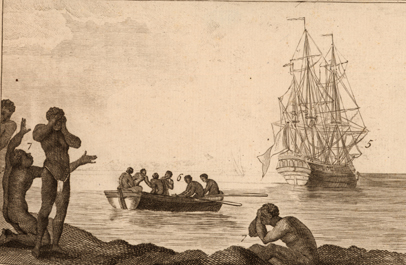
|
February 26, 2007 |
Slavery and Justice
Brown Libraries Host Four Exhibitions on Slavery in the Americas
Four exhibitions currently on display at three Brown University Libraries offer the community a chance to view some of the original documents, journals, cargo invoices, newspaper advertisements and engravings cited in the Report of the Brown University Steering Committee on Slavery and Justice. The exhibitions, which document the history of African slavery and its impact on the Western Hemisphere, are free and open to the public. | |||
|
Brown University Home |
PROVIDENCE, R.I. [Brown University] — Four exhibitions related to slavery and the slave trade in the Americas are currently on display in three libraries at Brown – the John D. Rockefeller Jr., John Hay, and John Carter Brown Libraries – in connection with the Report of the Brown University Steering Committee on Slavery and Justice, published in October 2006. These exhibits display books, manuscripts and other items in the Brown libraries from 1638 to 1948, documenting the history of African slavery and its impact on the Western Hemisphere – especially New England and the Caribbean. Many of the items are cited in the Slavery and Justice Report.  Bound and headed for America “The authors of the Slavery and Justice Report made extensive use of these and other materials held at the John Hay Library and the John Carter Brown Library,” said Harriette Hemmasi, the Joukowsky Family University Librarian. “We are pleased to open our collections to the community so that they may also examine, first-hand, these important documents found among our libraries’ rich holdings.” In the lobby of the Rockefeller Library, visitors can see advertisements for slaves that ran in the Newport Mercury in 1760, published narratives of former South County slaves, and a printed roster of the famous Rhode Island “slave regiment” which fought in the Revolutionary War. Also on display are several documents from Brown’s early history relating to slavery and abolition. The central document on display is the original 1770-1771 account for the construction of University Hall, a facsimile of which hangs on the first floor of University Hall and is cited in the Slavery and Justice Report as “an apt metaphor for a history that has long hidden in plain sight.” Alongside this account is an anti-slavery Commencement oration from 1798 delivered by graduating senior James Tallmadge. Both of these documents are available online at http://dl.lib.brown.edu/slaveryandjustice/. The exhibit will remain open until the end of April. The Rockefeller Library is located on the corner of Prospect and College streets and is open Monday through Friday from 8:30 a.m. to 2 a.m., Saturday from 10 a.m. to 10 p.m., and Sunday from 10 a.m. to 2 a.m. Across College Street is the John Hay Library’s exhibition, Venus in Chains: Representations of Sex and Slavery in the Caribbean Basin. This exhibit focuses on representations of slave women in the Caribbean basin from the 18th and 19th centuries, particularly in the accounts of European travelers and residents of the region. Featuring diverse texts and images from the John Hay and John Carter Brown libraries, including multivolume histories, daily life prints, abolitionist propaganda, and grotesque cartoons and caricatures, the exhibit highlights the variety of stereotypes about slave women that were prominent in European racial ideology, and demonstrates the ways in which slavery intertwined with sexual desire, particularly of white men for slave women, and reinforced the subjugation of women in this system. Venus in Chains will remain open through March 15. The library hours are 9 a.m. to 5 p.m., Monday through Friday. The John Hay Library is located at 20 Prospect St. In the John Carter Brown Library (JCBL), located on The College Green, are two related exhibitions, which will be open until the end of May. Six cases in the MacMillan Reading Room are devoted to Slavery and Justice: Selected Sources from the JCBL, including some of the documents referred to in the Slavery and Justice Report. The most notable of these include a letter from Carter Braxton, a Virginia plantation owner and signer of the Declaration of Independence, offering to invest in the voyage of the slave ship Sally, and the ship’s log book, which details the deaths of slaves that occurred on board almost daily. Also on display is the only surviving plan of University Hall before it was built (1770); a printed plea from Brown Trustee Ezra Stiles for donations to send a young freed slave back to his homeland (1776), which was supported by the famous African-American poet Phillis Wheatley; one of George Washington’s personal account books (1799) containing references to Africans in Mount Vernon; and a published autobiography of William J. Brown, a grandson of one of Moses Brown’s slaves (1883). 
The Haitian Liberator The other exhibit at the John Carter Brown Library, on display in the Maury A. Bromsen–Simón Bolívar Room, is titled Portrait of a Revolution. It focuses on the slave revolt in St. Domingue (Haiti) in 1791, and its famous leader, Toussaint Louverture. In Madison Smartt Bell’s new biography of Toussaint, he is described as the “highest achieving African-American of all time,” as the “leader of the only successful slave revolution in recorded history,” and the “founder of the only independent black state in the Western Hemisphere.” The cases in the Bolívar Room contain various portraits and descriptions of Toussaint, maps and views of St. Domingue, and illustrations of the conflict. The John Carter Brown Library is open Monday through Friday, from 8:30 a.m. to 5 p.m. and Saturday from 9 a.m. to noon. Editors: Brown University has a fiber link television studio available for domestic and international live and taped interviews, and maintains an ISDN line for radio interviews. For more information, call (401) 863-2476. ###### | |||